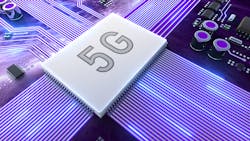This article is part of the TechXchange: PCB Tools and Technology
What you’ll learn:
- How selecting the right materials is crucial in creating 5G-capable PCBs.
- Addressing EMI and thermal-management issues.
- The role of automated inspection.
With “game-changing” 5G technology now emerging, a number of new market opportunities are slated to open up. However, for industries to benefit from this industrial revolution, multilayer PCBs must keep pace technologically since they’re at the heart of this revolution.
What follows are the key aspects that need to be addressed when it comes to circuit-board design and manufacturing for the 5G era.
Mixed-Signal Acceptance
Many of today’s devices are working on old-generation PCBs. This implies that transmission and receipt of frequencies is in the 600-MHz to 5.925-GHz range, with bandwidth channels of 20 MHz, or 200 kHz for the Internet of Things. However, 5G will require millimeter-wave (mmWave) frequencies of 28, 30, or 77 GHz in line with the application. For bandwidth channels, 5G systems will be dealing with 100 MHz below, and 400 MHz right above, 6-GHz frequencies.
To cater to these speeds and frequencies, the choice of materials is crucial in terms of avoiding signal loss. The materials also need to address the increasing miniaturization of devices as well as be lightweight and flexible.
Furthermore, materials need to offer a low dielectric constant. Fiberglass weaves and low-profile copper are two such options.
EMI Shield
Often 5G circuit boards must contend with EMI, crosstalk, and parasitical capacitance. To help solve those issues, it’s imperative that the traces are separated. With a multilayered board, it’s easy to position the high-speed traces in a way whereby the routes for analog and digital signals are kept far from each other.
The use of robotic automated optical inspection (AOI) systems and 2D metrology will go a long way in identifying any signal-degradation problems.
Thermal-Management Issues
With high-speed signals also comes more heat, and it’s incumbent on PCB materials to handle the temperature rise. Thus, it’s important to select materials with high thermal conductivity and thermal coefficients so that they’re capable of high heat dissipation and have a steady dielectric constant.
Design Aspects
PCB geometry plays a crucial role in PCB design. Laminates should have a thickness between 1/4 and 1/8 of the highest operating frequency's wavelength. If the laminate is too thin, you stand the risk of it resonating waves through the conductors.
In terms of transmission lines, the type of conductor that you use plays an important role. Microstrips work well, although they have issues with spurious-mode propagation above 30 GHz. Striplines are a great option, but they are costly to manufacture. GCPWs also work well, but their conduction losses are higher than that of microstrips and striplines.
Other recommendations for PCB Design in the 5G space:
- Ensure that the material chosen has low dielectric constant.
- Don’t use too much solder mask due to its moisture absorption capacity.
- Ensure that the copper traces are smooth. An irregular copper surface will offer an irregular path that will in turn increase the resistive losses.
- Because high-density interconnections require thinner tracks, signal degradation becomes a major issue. Traditional PCB manufacturing processes, namely the subtractive process, come with the disadvantage of making tracks with trapezoidal cross sections, which impact the impedance of the tracks. This issue can be resolved using a semi-additive fabrication process, leading to traces with greater precision.
- With a 5G circuit board, it’s imperative that robust automatic inspection procedures be carried out. They go a long way in ensuring that the quality of the product is maintained, and any errors and inefficiencies are brought to the fore. They also significantly save on the time and costs that accrues from manual inspections. In fact, automated inspection techniques are key factors in overcoming a number of challenges associated with 5G, particularly those involving impedance control.
Adhering to the above checks and balances will help deliver high production rates as well as consistent performance, is a given.
About the Author
Suresh Patel
Sales Engineer, Mer-Mar Electronics
Suresh Patel has worked as a Sales Engineer and held other management roles at Mer-Mar. He brings 25 years of experience in printed-circuit-board sales and technical client service and managing business.
